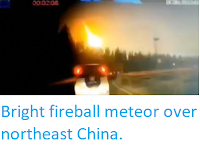Asteroid 2018 EB passed by the Earth at a distance of about 16 321 000
km (42.5 times the average distance between the Earth and the Moon, or 10.1% of the distance between the Earth and the Sun), slightly before
1.25 am
GMT on Wednesday 7 October 2018. There was no danger of
the asteroid hitting us, though were it to do so it would have
presented a significant threat. 2018 EB has an estimated
equivalent
diameter of 82-260 m (i.e. it is estimated that a spherical object
with
the same volume would be 82-260 m in diameter), and an object at the
upper end of this range would be predicted to be capable of
passing through the Earth's
atmosphere relatively intact, impacting the ground directly with an
explosion that would be about 4000 times as powerful as the
Hiroshima
bomb. Such an impact would result in an impact crater over 4 km
in
diameter
and devastation on a global scale, as well as climatic effects that
would last years or even decades.
Radar image of 2018 EB and its moon S/2018 (2018 EB) 1. Arecibo Observatory.
2018 EB was discovered on 1 March 2018 by the Wide-field Infrared Survey Explorer
satellite. The designation 2018 EB implies that it was the second
asteroid (asteroid B) discovered in the first half of March 2018
(period 2018 E). On 7 October 2018, during another close approach of the asteroid to the Earth, the Arecibo S-band (2380 MHz, 13 cm) radar in Puerto Rico and the Goldstone X-band (8560 MHz, 3.5 cm) radar in California surveyed 2018 EB again, discovering that the asteroid has a small moon, which was given the designation S/2018 (2018 EB) 1, implying the first known satellite of 2018 EB, that was discovered in 2018.
The calculated orbit and current position of 2018 EB. JPL Small Body Database Browser.
2018 EB has a 374 day orbital period and an eccentric orbit
tilted at an angle of 29.4° to the plane of the Solar System, which
takes it from 1.00 AU from the Sun (i.e. 100% of he average distance at
which the Earth orbits the Sun) to 1.03 AU from the Sun (i.e. 103% of
the
average distance at which the Earth orbits the Sun). It is therefore
classed as an Amor Group Asteroid (an asteroid which comes close to the
Earth, but which is never closer to the Sun than the Earth is). As
an asteroid probably larger than 150 m in diameter that occasionally
comes within 0.05 AU of the Earth, 2018 EB is also
classified as a Potentially Hazardous Asteroid. Close
encounters between the 2018 EB and Earth are extremely common, with the
last having happened in April this year and the next predicted
in April 2020.
See also...
Follow Sciency Thoughts on Facebook.








